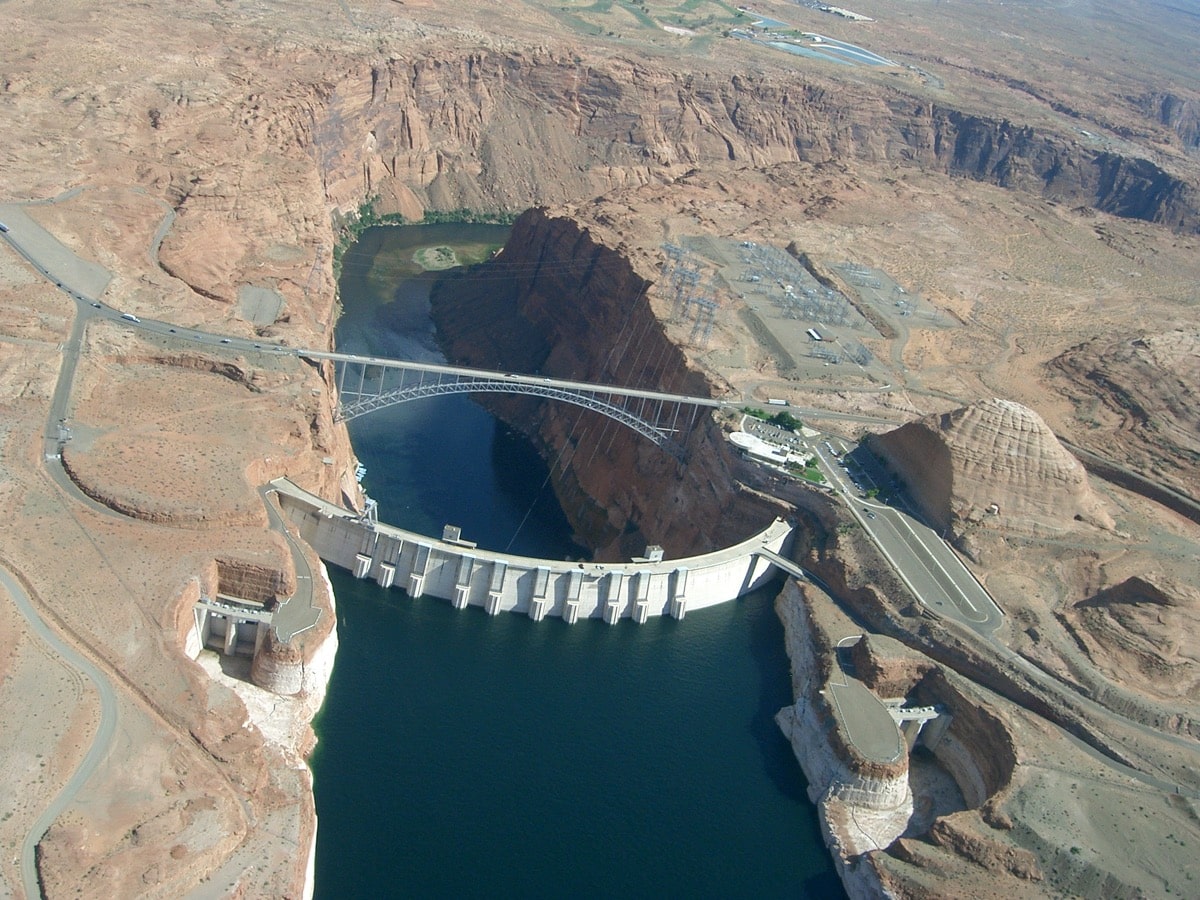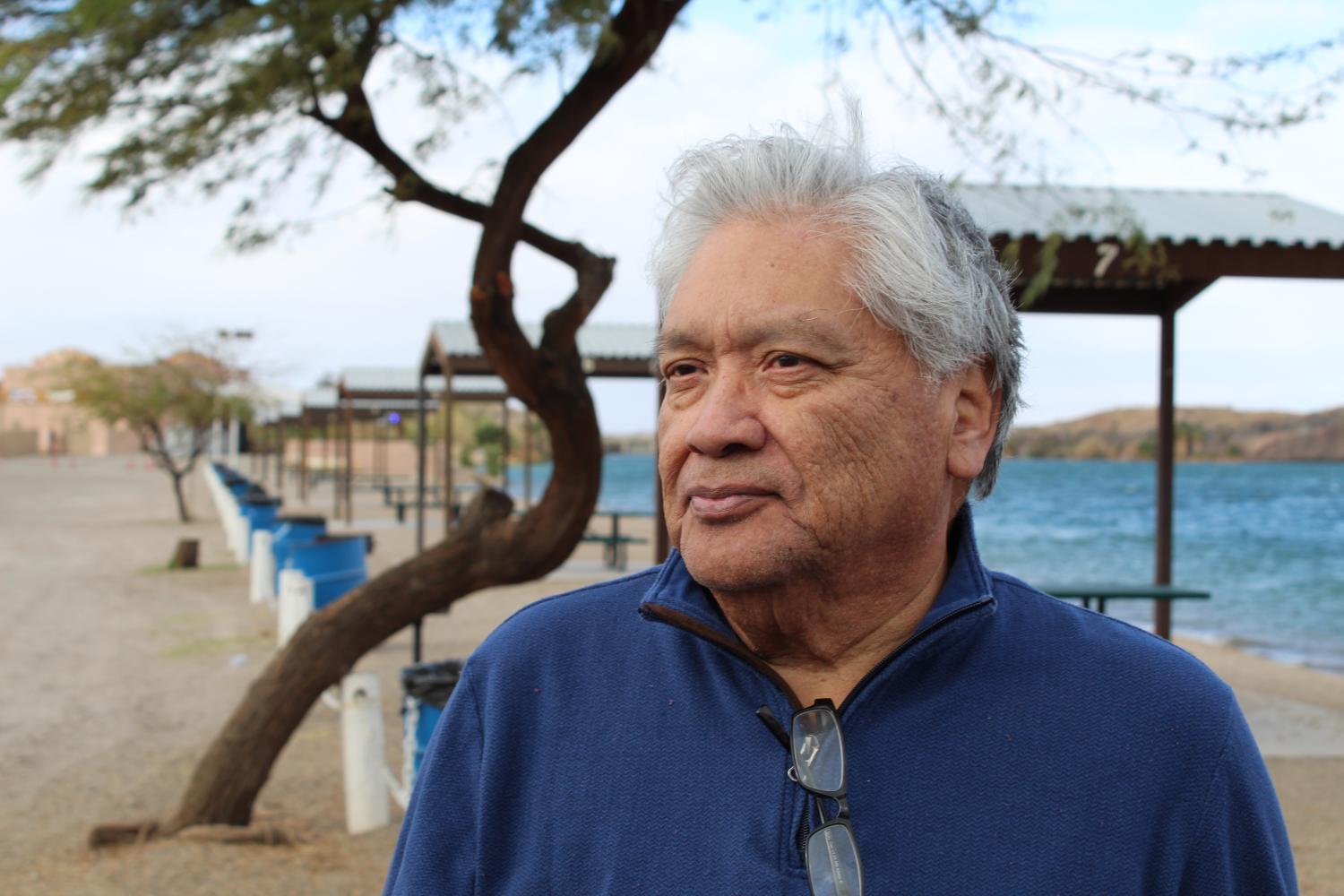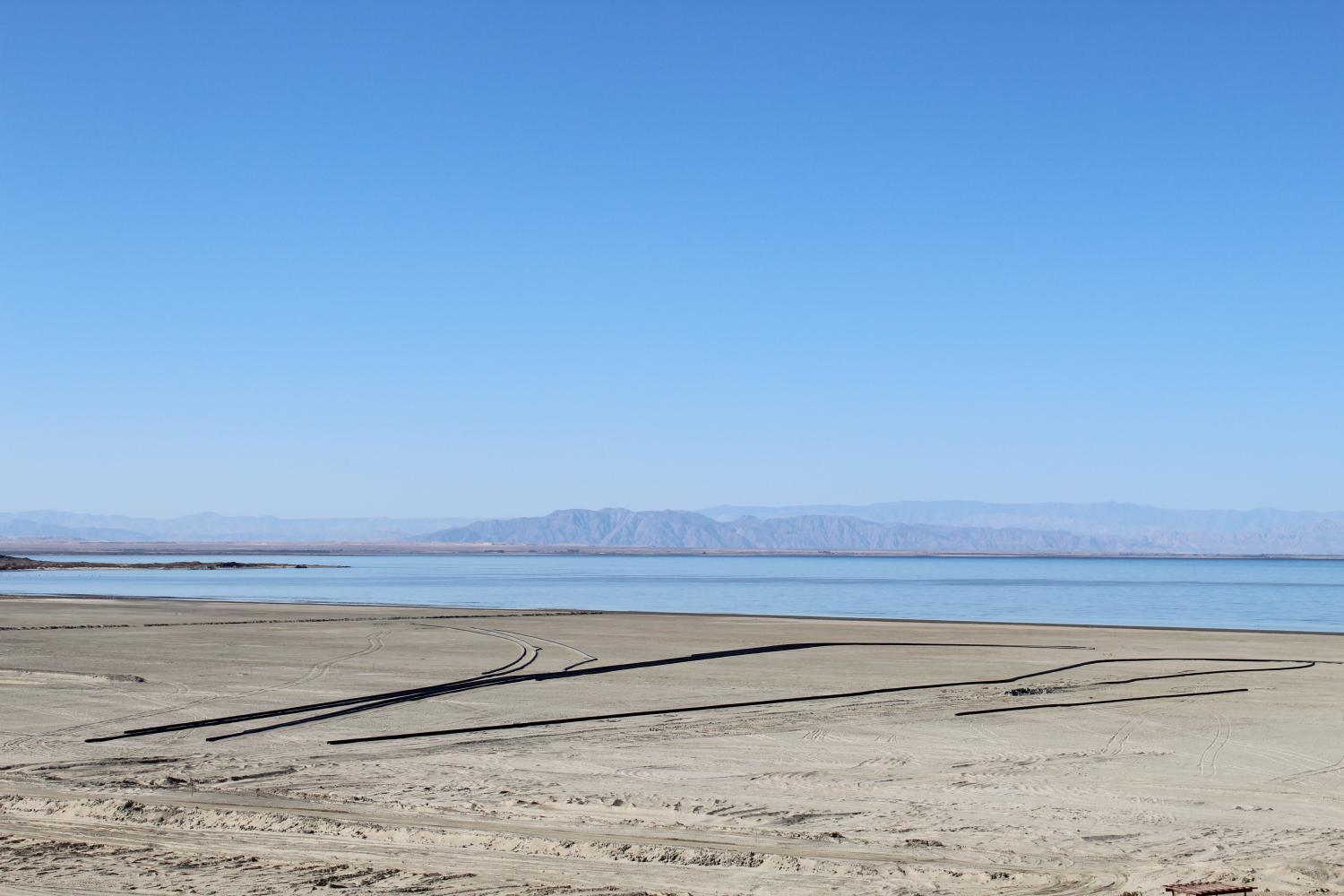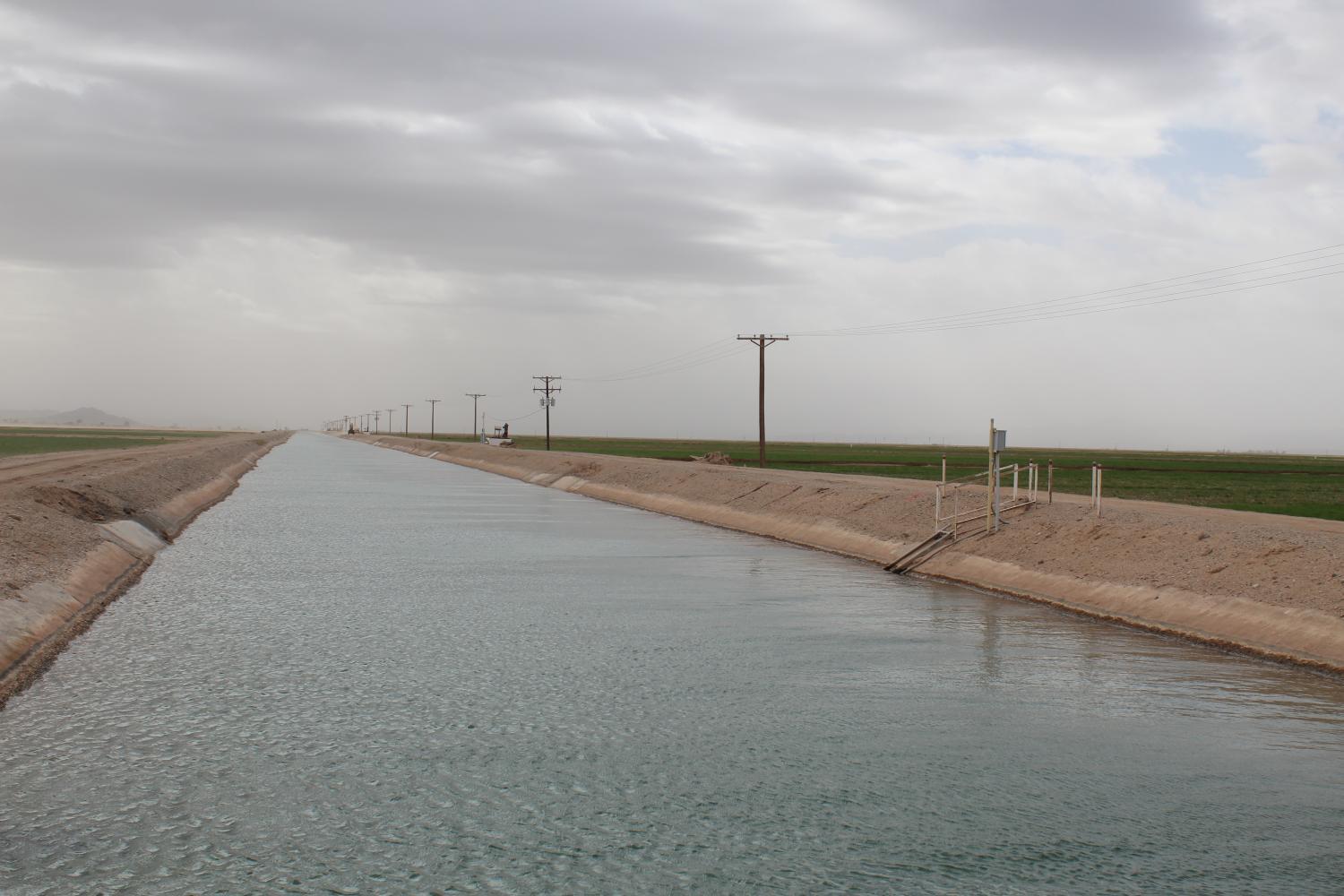How Will Arizona Battle Drought In The Next Decade?
4:41 minutes

This segment is part of The State of Science, a series featuring science stories from public radio stations across the United States. A version of this story, by Bret Jaspers and Luke Runyon of KUNC, originally appeared on KJZZ in Phoenix. This story is part of Elemental: Covering Sustainability, a multimedia collaboration between public radio and TV stations in the West.
States that rely on the Colorado River for their water supplies are currently unable to finish a series of agreements that would keep its biggest reservoirs, Lake Mead and Lake Powell, from dropping to levels not seen since they were filled decades ago.
Five states—Colorado, Utah, New Mexico, Wyoming and Nevada—are done. The country of Mexico has also completed its portion. But California and Arizona failed to meet a Jan. 31 federal government deadline to wrap up negotiations and sign a final agreement.
The Colorado River is stressed. Simply put, the system of reservoirs and streams has a fundamental imbalance between supplies and demands, a gap that’s growing in size due to long term warming and drying trends in the southwestern U.S.
The Drought Contingency Plan, made up of agreements between the river’s two basins, is designed to rein in water use and—at least for six years—prevent the whole system from crashing.
Without the plans in place, U.S. Bureau of Reclamation Commissioner Brenda Burman said she’ll be forced to take matters into her own hands. Burman has issued a new deadline of March 4 for states to finish the plans, or she said she will begin collecting comments from the state’s governors on how to solve the region’s water scarcity conundrum.
“We’re at a point where two roads are diverging in the woods,” Burman told reporters on Feb. 1. “And we need to decide which path we’re going to follow.”
The first path is the one the seven states are on now, where the parties are working collaboratively to finish the plans and put them into action themselves. Some language in the plans would then need approval by Congress and the president.
The other path, Burman said, involves invoking the federal government’s “broad authority” to manage how water is distributed in the river’s Lower Basin. But as tensions rise in some of the areas where the plans remain unfinished, some users are ready to challenge that authority.
Let’s go through a few points to understand where the drought plans stand now:
Hours ahead of the midnight deadline on the afternoon of Jan. 31, a group of Arizona lawmakers and water users gathered in the old State Capitol building to watch Gov. Doug Ducey sign a resolution giving the state’s top water official the ability to sign on to the Drought Contingency Plan.
The signing was a celebration, a culmination of months of discussion in the state that laid bare hard truths about Arizona’s water past, present and future.
Earlier in the day, as the Legislature prepared to vote on the measure, Republican House Speaker Rusty Bowers talked about just how hard it’s been.

“There are hundreds and hundreds of people who’ve worked on these two bills that we have before us,” said Bowers. “All kinds of associations and groups have focused their attention on this. And we hope that this, as has been declared, this first step, will be beneficial to all of us.”
Negotiations brought in some groups that hadn’t been included in the past, like the Colorado River Indian Tribes, based in Western Arizona.
“This was our first run at [the Drought Contingency Plan] and we were very confused,” said Chairman Dennis Patch. “And we’re a lot smarter now. We hope to continue to work with the state on all water issues that come up.”
With Arizona on board, the Associated Press declared the process complete.
But while Arizona was celebrating its big milestone, the federal government came in and crashed the party, saying the state didn’t do enough for the deal to be considered “done.”
Leading up to the deadline, the federal government was vague on what “done” actually meant. That led to claims that the goalposts for completion were changed last minute on the state while it was struggling to find consensus.
Reclamation’s Burman said additional agreements among the state, individual water districts and tribes were left incomplete. The federal hammer would remain until those groups signed on.
“We met the deadline and the federal government is not in charge of our water,” Ducey spokesperson Patrick Ptak said in an email to reporters. “It’s time for others to do the same.”
California’s Imperial Irrigation District hasn’t been shy about its concerns over the declining Salton Sea in negotiations about the river’s future. The IID is the single largest user of Colorado River water.
Since early 2018, the district’s board has said they won’t sign a broader deal until they get more resources to manage the Salton Sea’s ever-expanding shoreline and its spiking salinity levels. A 15-year-old agreement led to a transfer of water from the district to growing cities in southern California. That, and increasing irrigation efficiency, have led to the lake’s dwindling water supply, causing environmental and public health problems as it shrinks.

California too was singled out by Burman for failure to meet her Jan. 31 deadline, a fact that ruffled feathers at IID.
“No federal coercion was needed to reach this point of near completion,” said IID board member James Hanks at a Feb. 5 special meeting. “And we don’t need it now.”
Hanks said Burman has “dodged questions” about Salton Sea mitigation funds, and about Reclamation’s role in addressing the lake’s growing list of problems. He also challenged whether the federal government truly had authority to begin meddling in Colorado River water allocations and entitlements.
While the Drought Contingency Plans focus their attention on preserving water levels in Lakes Mead and Powell, Hanks said the Salton Sea is part of the broader Colorado River system too and its future should be included in the negotiations.
“Are the golf courses of Phoenix, the fountains of Las Vegas more important than the public health crisis at the Salton Sea?” Hanks said.
IID is seeking to secure a federal match of $200 million in Farm Bill funds for projects at the Salton Sea. Those funds have not yet been allocated. In December, IID board members said they’d support the Drought Contingency Plan if three conditions were met, one being that the board would be able to vote on a full package of agreements when they were done. That hasn’t happened yet.
Water managers seem to agree that states need to use less water from the river. But when it comes down to who actually uses less, that’s when the tension starts to rise.
“This is where the rubber meets the road, or where the raft meets the river, I don’t know what the metaphor is,” said John Berggren, a policy analyst with Western Resource Advocates, a Boulder, Colorado-based environmental group.
“That’s where you get into the issues and get into the real wickedness of the problems because you’re dealing with people’s livelihoods, you’re dealing with people’s values, you’re dealing with long-term, fundamental changes to winners and losers.”
Western Resource Advocates receives funding for some of its work from the Walton Family Foundation, which also provides funding for KUNC’s Colorado River coverage.
If they’re finished, these deals won’t be in place for very long—scheduled to expire in 2026.
Some have criticized the Drought Contingency Plan for not going far enough to solve the region’s water problems.
Even the name of the deal—the Drought Contingency Plan—seems to suggest we’re dealing with a temporary dry period, rather than an overall shift in climate.
John McClow is general counsel for the Upper Gunnison River Water Conservancy District and an alternate commissioner on the Upper Colorado River Commission.
“Most of the policymakers in the West are persuaded that we have aridification rather than drought,” McClow said. “Many folks now are saying, ‘This is what we can expect. It’s not going to get better.”
The current plans have been crafted as a response to shortcomings in river guidelines agreed to in 2007, when water leaders were grappling with the first few years of a now 19-year dry period.
Climate change and over-allocation are thorny issues that will come up almost immediately once Drought Contingency Plans are finished.
The 2007 guidelines are set to expire in 2026, and water managers are required to begin negotiating that new agreement next year. McClow said as soon as water managers wrap up these Drought Contingency Plans, they immediately have to take on a new set of even harder negotiations, and the current process to keep the reservoirs from crashing will likely make that renegotiation only marginally easier.
“It’s going to be hard no matter what,” McClow said. “Both basins have ideas about things that need to be fixed and they’re not compatible in some cases. It’s going to be a difficult negotiation.”
Those talks are supposed to render a long-term solution. But short-term weather adds a degree of uncertainty too. Many streams in the basin are projected to have less than average flows throughout this spring and summer, a symptom of an ongoing drought hangover from 2018.

And that could end up adding even more pressure to the river and the people in charge of managing it.
Even so, the process in Arizona has some water managers hopeful about the next round of talks.
“Over the last five to 10 years what I’ve noticed as a positive is, those tribalistic instincts seem to be going away,” said Shane Leonard, general manager of the Roosevelt Water Conservation District in central Arizona. “They’re definitely still there. But they’re not as hard as they used to be.”
Luke Runyon reports for KUNC, based in Greeley, Colorado. Bret Jaspers reports for KJZZ in Phoenix.
This story is part of Elemental: Covering Sustainability, a multimedia collaboration between public radio and TV stations in the West, and part of a project covering the Colorado River, produced by KUNC and supported through a Walton Family Foundation grant. KUNC is solely responsible for its editorial content.
Invest in quality science journalism by making a donation to Science Friday.
Bret Jaspers is a reporter at KJZZ in Phoenix, Arizona.
IRA FLATOW: Now, it’s time to check in on the State of Science.
SPEAKER 1: This is KPR.
SPEAKER 2: WWNO.
SPEAKER 3: St. Louis Public Radio.
SPEAKER 4: Iowa Public Radio News.
IRA FLATOW: Stories of national significance right in your neighborhood. Out West, water as you know is a big issue and will become a bigger issue with drought and climate change. The seven states that depend on the Colorado River for water are drawing up their own plans to prevent future shortages.
Two states– California and Arizona failed to meet a federal deadline last month, so the government has given them another month to hammer out a final agreement. We’re going to focus in on Arizona. My next guest is here to take us through the details of that state’s proposal. Bret Jaspers– he’s a reporter for KJZZ in Phoenix. Welcome.
BRET JASPERS: Hi, thanks for having me.
IRA FLATOW: Arizona has allocated a specific amount of water from the Colorado and has to figure out how to distribute this throughout the state, right? How much does Arizona have to work with?
BRET JASPERS: That’s right. So Arizona is entitled to 2.8 million acre feet. That doesn’t mean that they don’t get a little bit more sometimes. But that’s what is going to– part of that is going to be cut back with this, what they call the Drought Contingency Plan, about 500,000 acre feet. And so figuring out where those cuts go and how they’re distributed legally is what the bulk of their negotiations have been over the last year or so.
IRA FLATOW: And every state has their own way of tackling how to budget its water. How does this work in Arizona?
BRET JASPERS: Well, in Arizona the portfolio for the whole state– and it’s different for each user within the state, but the sources are the Colorado River, in-state rivers, groundwater, and reclaimed water. And there’s legal claims on all of those different sources from various users. So when Colorado River water gets cut back, that will affect only certain users within Arizona.
And so the state as a whole does get 40% of its water from the Colorado. But the particular users that are being affected with this Drought Contingency Plan are people who are in the center of the state, who are getting Colorado River water through a canal system that we have.
IRA FLATOW: So the state must have a way of prioritizing who gets the water usage, right?
BRET JASPERS: That’s right. And it’s all kind of been laid out legally for generations. And so there are certain Native American tribes, and certain cities, and irrigation districts which serve farmers and other users that have what they’re entitled to purchase each year, kind of laid out in a priority system.
And that’s been a big sticking point for some users, that they want to really maintain that priority system, even as we scale back and have to maybe help users that will be most cut. Because they’re at the back– they’re at the end of the line and will be hurt economically.
IRA FLATOW: When you say help them, does that mean you’ll give them funds instead of water?
BRET JASPERS: Well, if I can take just one particular group, there’s a group of central Arizona farmers that are at the back of the line. And they’re in the back of the line because of past agreements, where they’ve gotten money in exchange for their position in line to get Colorado River water.
But because we’re scaling back now, because of drought and climate change, they will suffer economically. So what they’re going to get under Arizona’s designed plan is some water that’s been stored in the Lake Mead, which is the main reservoir for the state and of the Colorado River system. They’re going to get some of that stored water.
And then, for example, an Indian tribe on the western part of the state is going to fallow some land, so that they can then in exchange save water in Lake Mead to make sure that the lake doesn’t suffer. And it’s a way to– it’s kind of an accounting deal that they’ve made with the Drought Contingency Plan, is how do we keep water in the lake and yet, send some water to people that are going to not get what they expected to get?
IRA FLATOW: Water– it’s the next big thing, right? Southwest–
BRET JASPERS: Absolutely.
IRA FLATOW: –appropriating water and how to use it. So thank you, Bret. Bret Jaspers is a reporter for KJZZ in Phoenix, Arizona. We’re going to take a break. And get out your reading glasses, because the SciFri Book Club returns to tackle all kinds of stuff.
We have geoscience disasters in society with N.K. Jemisin’s book, The Fifth Season. We hope you’ve been reading it. It’s a long book, but really interesting stuff in there. We’ll talk about how it might pertain to real life. Stay with us. We’ll be right back after this break. Our number– 844-724-8255 for the book club. I’ll be right back.
Copyright © 2019 Science Friday Initiative. All rights reserved. Science Friday transcripts are produced on a tight deadline by 3Play Media. Fidelity to the original aired/published audio or video file might vary, and text might be updated or amended in the future. For the authoritative record of Science Friday’s programming, please visit the original aired/published recording. For terms of use and more information, visit our policies pages at http://www.sciencefriday.com/about/policies/
Alexa Lim was a senior producer for Science Friday. Her favorite stories involve space, sound, and strange animal discoveries.
Ira Flatow is the founder and host of Science Friday. His green thumb has revived many an office plant at death’s door.